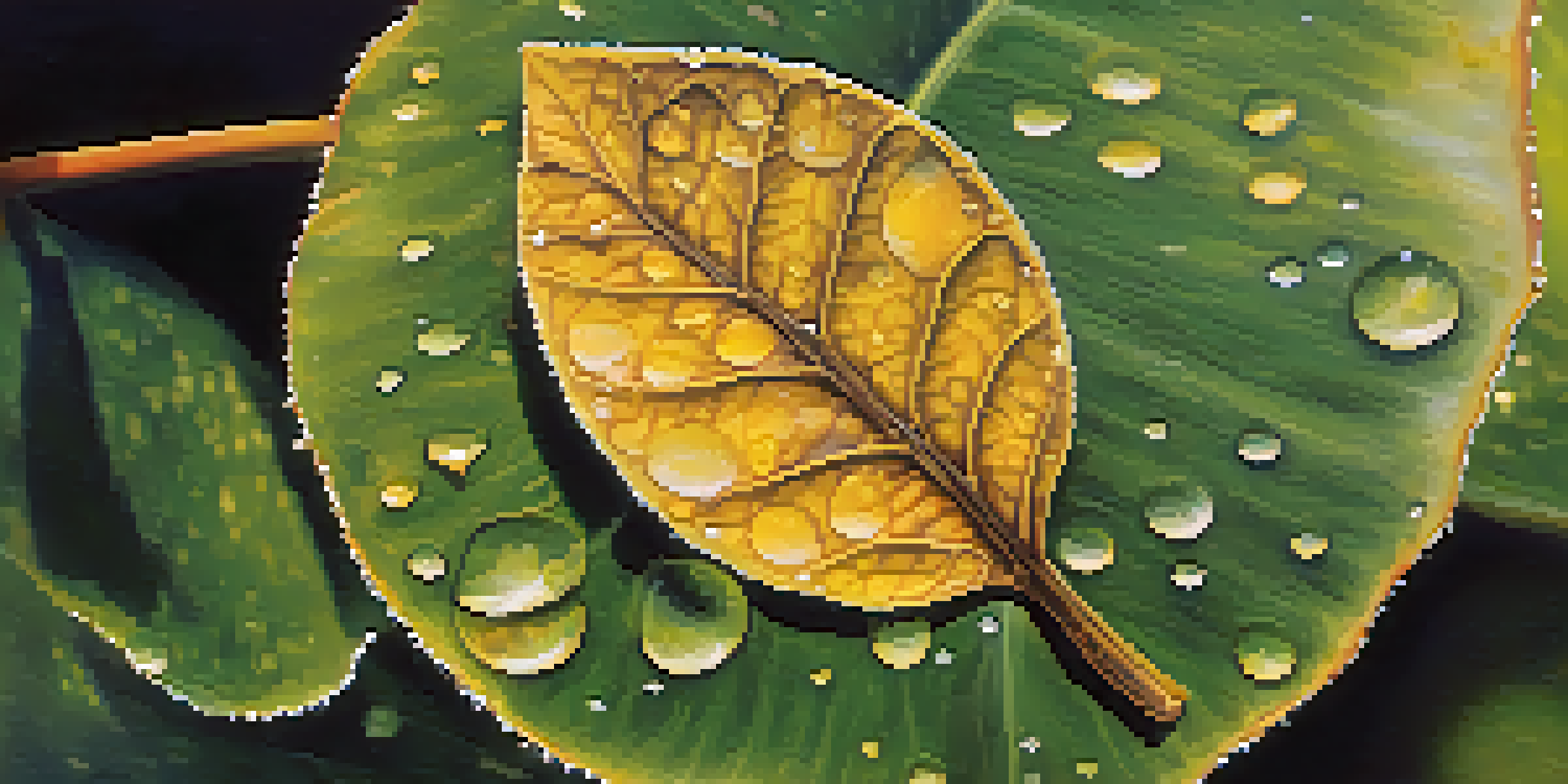Identifying and Managing Leaf Spot Diseases in Plants

Understanding Leaf Spot Diseases and Their Causes
Leaf spot diseases are common plant ailments that manifest as dark, discolored patches on leaves. These spots can vary in color, size, and shape, often caused by fungi, bacteria, or environmental conditions. Understanding the causes behind these diseases is crucial for effective management and prevention.
An ounce of prevention is worth a pound of cure.
Fungal infections, like those caused by Alternaria or Septoria, are the most prevalent culprits. They thrive in warm, moist conditions, making certain climates particularly susceptible. Bacterial leaf spots, on the other hand, can spread rapidly, especially in humid environments, leading to more severe damage if not addressed promptly.
Environmental factors such as poor air circulation, overwatering, and inadequate sunlight can also contribute to the development of leaf spot diseases. Recognizing these causes can empower plant owners to take proactive measures in maintaining plant health.
Identifying Common Symptoms of Leaf Spot Diseases
Early identification of leaf spot diseases is key to managing them effectively. Symptoms typically include small, round, or irregular spots that can appear brown, black, or yellow, depending on the pathogen. As the disease progresses, these spots may merge, leading to larger areas of leaf tissue dying.

In addition to discoloration, you might notice a yellow halo surrounding the spots, which can help distinguish between different types of leaf spots. Affected leaves may also exhibit wilting or curling, and in severe cases, entire leaves may drop off, impacting the plant's overall health.
Identify Leaf Spot Symptoms Early
Recognizing symptoms like discoloration and wilting quickly allows for timely intervention, preventing further spread.
Observing these symptoms regularly allows you to intervene early, preventing the spread of the disease to other plants. Keeping an eye on your plants can save you time and effort in the long run.
How to Diagnose Leaf Spot Diseases Accurately
Diagnosing leaf spot diseases involves careful observation and sometimes consulting resources or experts. Start by examining the spots closely for patterns, color, and texture, as these characteristics can provide clues about the type of disease. For instance, fungal spots often have a velvety texture, while bacterial spots are typically water-soaked.
The best way to predict the future is to create it.
You can also take a sample of the affected leaf to a local extension office or plant clinic for analysis. Swift diagnosis is essential, as it allows you to choose the most effective treatment method for the specific pathogen involved.
Additionally, keeping a garden journal to record symptoms, weather conditions, and plant care practices can help identify recurring issues. This proactive approach not only aids in diagnosing current problems but also prevents future outbreaks.
Preventative Measures to Avoid Leaf Spot Diseases
Prevention is often the best strategy for managing leaf spot diseases. Start by selecting disease-resistant plant varieties whenever possible, as they are less likely to succumb to common ailments. Additionally, planting in well-draining soil and ensuring proper spacing between plants can improve air circulation and reduce humidity, creating an unfavorable environment for pathogens.
Regular maintenance, such as pruning dead or infected leaves and avoiding overhead watering, can significantly limit the spread of diseases. Instead, water plants at the base to keep foliage dry, which helps deter fungal growth.
Prevent Leaf Spots with Care
Implementing preventative measures such as selecting disease-resistant plants and improving air circulation can significantly reduce the chances of leaf spot diseases.
Furthermore, practicing crop rotation and diversifying your plant selections can disrupt the life cycles of pathogens. Incorporating these preventative measures into your gardening routine lays the foundation for healthier plants.
Effective Treatment Options for Leaf Spot Diseases
When leaf spot diseases do occur, timely treatment is crucial. Chemical fungicides can be effective against fungal infections, but they should be used judiciously and according to label instructions. There are also organic options, such as neem oil or copper-based fungicides, that can provide relief without harming beneficial insects.
For bacterial leaf spots, improving air circulation and reducing humidity can help mitigate the spread. Some gardeners find success using a mixture of baking soda and water as a homemade treatment, although its effectiveness can vary.
Always remove and dispose of infected leaves to minimize the risk of reinfection. Implementing a combination of treatments and preventative measures will give your plants the best chance of recovery.
The Role of Environmental Conditions in Disease Management
Environmental conditions play a significant role in the development and management of leaf spot diseases. Factors like humidity, temperature, and soil moisture levels can either exacerbate or lessen the severity of outbreaks. For instance, prolonged wet conditions can favor fungal growth, while dry, sunny days may help reduce disease spread.
Being mindful of these conditions allows you to adjust your care routine accordingly. For instance, if a rainy season is expected, consider changing your watering habits and ensuring that your plants are not overcrowded, which can trap moisture.
Seek Help for Severe Issues
When leaf spot diseases escalate, consulting professionals can provide accurate diagnoses and targeted treatment recommendations.
Creating a suitable environment for your plants not only helps prevent leaf spot diseases but also promotes overall plant health. This holistic approach can make your gardening experience more enjoyable and successful.
When to Seek Professional Help for Leaf Spot Issues
Sometimes, despite best efforts, leaf spot diseases can escalate beyond what DIY methods can handle. If you notice a rapid spread of symptoms or if your plants seem to be declining despite treatment, it may be time to seek professional help. Local agricultural extensions or plant clinics can provide expert advice tailored to your specific situation.
Professional services may also offer diagnostic testing that can accurately identify the pathogen causing the issue. This information is invaluable, as it allows for targeted treatments that can save your plants.

Furthermore, consulting with a horticulturist can provide insights into long-term management strategies and preventative measures, ensuring that your garden remains healthy and vibrant for seasons to come.